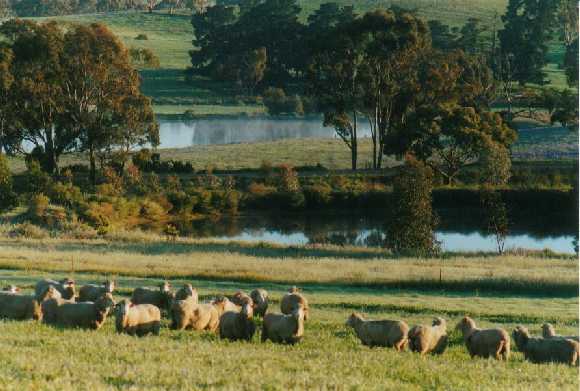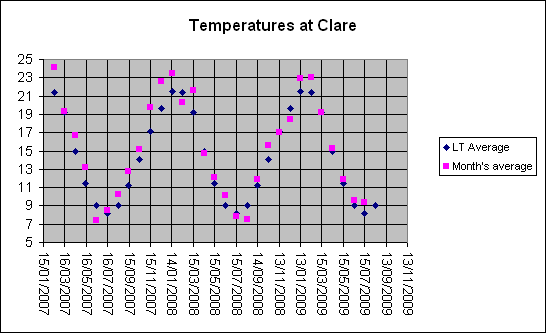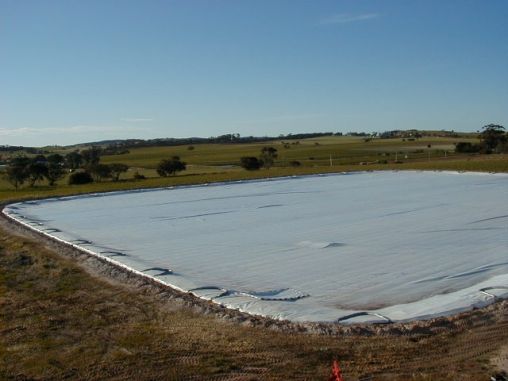| |
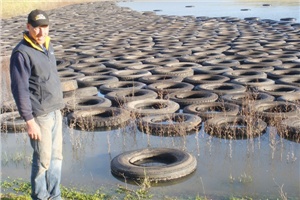
|
AgFloats (Mark 1) recycled tires on a community dam at Blyth, SA
Photo credit Northern Argus
|
|
|
|
|
Update
Reclaim went out of business a year or so after supplying my tires.
| |
A system that uses recycled tires as an evaporation barrier,
with polystyrene to make the tires
float, has been commercialised in South Australia under the name
AgFloats.
AgFloats is a product of Reclaim.
(An earlier version of AgFloats used recycled polystyrene, but a newer
process [September 2009] uses new foam (blown in before it hardened); with the hope of being able to use half recycled and half new at some time in the future.)
The business is based at 93 Frome St., Adelaide (phone
08 8232 3388),
and has another site at 20 Evans St., Woodside,
(SA, phone 08 8389 9544)
The person to talk to is John Crosby.
To my knowledge, the system has been used on at least one station
(NW of Kimba in South Australia).
The manager of that station told me that it had resulted in an 80% reduction
in evaporation.
As I write in July 2009, AgFloats are converting from a system based on
truck tires (Mark 1) to one based on car tires (Mark 2).
The latter have the advantage to the land-holder of being lighter and
easier to move, if that is necessary; Mr Crosby claims that the new
system will provide even greater evaporation reduction.
A disadvantage to the new system, in my mind, is that the polystyrene is
exposed to sunlight and will gradually degrade – although the tires
will provide some protection from the UV light.
Also, since the new system uses new polystyrene it is less
environmentally-friendly than the old system which used recycled.
Cost
As of July 2009, I believe the price of these has not been decided, because
of the conversion in the process, but I am lead to believe that they should
cost about $10 per square metre; about $7000 for my approximately
700m
2 dam.
My thoughts
This product seems to me to be the front runner in evaporation reduction
methods for farm dams (as of mid-2010).
Its price is much lower than
Aquacap and I like the
fact that it is using recycled tires that would otherwise go to land fill.
The tires should protect the polystyrene from degradation by ultraviolet
light.
I bought AgFloats
for my dam.
A quick Net search suggested to me that this product may still be available
for swimming pool covers, but not for dam covers.
| |
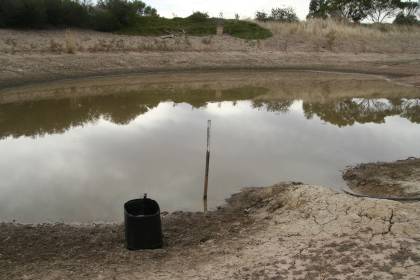
| First evap. gauge setup
Dam and tub
| |
| 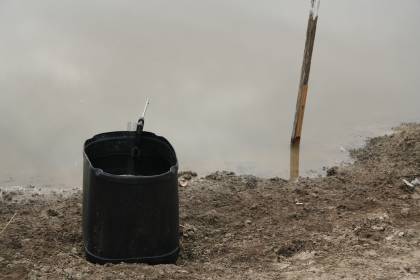
| | First evap. gauge setup.
Tub with its gauge, gauge in dam (there is a wooden ruler nailed to the
stake)
| |
| 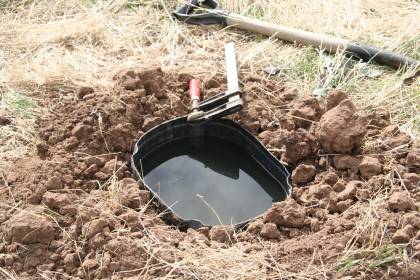
| | Second evap. gauge setup.
Tub buried to reduce solar heating; the clamp holds a ruler marked in
millimetres
| |
| 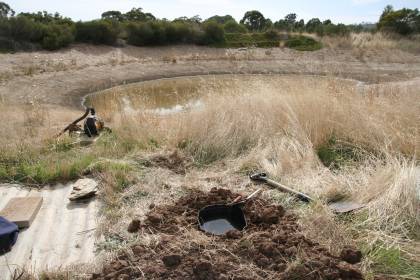
| Second evap. gauge setup
Tub and dam
| |
| 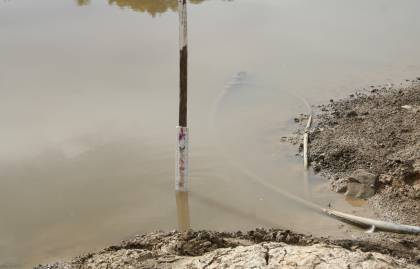
| Second evap. gauge setup
Gauge in dam
| |
Aquatain is a silicone based liquid that is spread in a very thin layer on
top of bodies of water to form a barrier stopping contact between water and
air and reducing the amount of loss to evaporation.
The maker, Guyco, claims Aquatain will reduce evaporation by more than 50%.
| |
|
In July 2016 I was contacted by some people who had run trials on a new
product made by the Aquatain company.
The new product is called WaterGuard and the people who contacted me
said that their trials indicated it worked well.
|
|
An Internet search that I conducted didn't show any independent research
that had been done on the effectiveness of Aquatain.
Aquatain has a site on the
Net.
I emailed Aquatain (info@aquatain.com.au) on 2009/03/02 inquiring about
whether any independent report of the product's effectiveness was available.
I received a reply from Peter Leach, (a/the) director of Aquatain
the following day.
Total Ag Services Pty, Ltd of Dalby, Qld. had done an evaluation in April
2007.
Peter Leach forwarded me a copy of this.
The trial was carried out over a three-week period and the gist of the
report was that the evaporation was reduced by about 50% during this period.
Mr Leach also forwarded a water test report which suggested that the water
quality was not adversely effected by Aquatain.
As I had bought 2½L of Aquatain I decided to do my own testing.
My trial involves comparing the changes in water level in a dam (treated
with Aquatain) with the changes in water level in a 20L drum, open at the
top.
My trial setup was very simple.
Note that seepage could affect the results of this trial, see
note below.
| Aquatain trial record
|
|---|
| 2009/02/28 | First evap. gauge setup
|
|---|
| Date | Dam loss
(mm) | Tub loss
(mm) | Saving
(mm)
| Saving
(%) | Notes
|
|---|
| 2009/02/28 | - | - | - | - | Aquatain added
|
| 2009/03/06 | - | - | - | - | Water level gauges installed
|
| 2009/03/07 | 7 | 6 | -1
| -17% | -
|
| 2009/03/08 | - | - | - | - | More Aquatain added
|
| 2009/03/10 | 12 | 19
| 7 | 37% | -
|
| 2009/03/12 | 12 | 12
| 0 | 0% | -
|
| Total, 1st trial | 31 | 37
| 6 | 16% | End first trial
|
| 2009/03/12 | Second evap. gauge setup
|
|---|
| Date | Dam loss
(mm) | Tub loss
(mm) | Saving
(mm)
| Saving
(%) | Notes
|
|---|
| 2009/03/15 | 21 | 19
| -2 | -11% | More Aquatain added
|
| 2009/03/24 | 49 | 41
| -8 | -20% | More Aquatain added
|
| 2009/03/29 | 10 | 15
| 5 | 33% |
|
| 2009/04/02 | 27 | 27
| 0 | 0% |
|
| Total, 2nd trial | 114 | 109
| -5 | -5% | Second trial
|
| Total | 145 | 146
| 1 | 1% | First and second trial
|
A flaw in my first trial setup was that the tub would be likely to get
quite hot in the sun and then the amount of evaporation from it would
increase due to this heating.
By setting the tub in the ground this disproportionate solar heating should
be avoided.
Conclusion
My trial indicated that Aquatain, at least in this particular setting,
is of no value.
There is a suggestion in the data that the layer disappears after only a
day or two.
Could it be that Aquatain is adsorbed onto the clay particles around the
edge of my dam?
Clay very effectively adsorbs many substances.
Perhaps Aquatain would work where it does not come into contact
with clay, for example, in the case of a plastic-lined dam?
Aquatain has been on the market for several years, it is readily available;
it was held in stock at my local irrigation supply store.
Many people must have tried it.
It is disappointing that no-one else had taken the little trouble needed
to investigate whether the stuff worked and put their results on the Net.
The above calculations do not take into account the possibility of seepage.
Measurements that I did in June and July of 2009 indicated that seepage in
my dam is negligible.
|
|
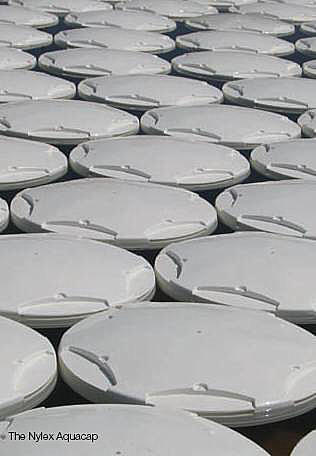
| Aquacap
Image from Nylex
| |
This product is by Nylex/Rio Tinto who have a Net page on the product at
http://www.aquacap.com.au.
It is claimed that Aquacap reduces evaporation by 85%.
The product is a circular floating disc made of polypropylene, 1.15m in
diameter, 200mm high and weighing 3kg each.
They are claimed to have been tested to wind speeds of 130kph.
Lifespan is claimed to be five years plus.
Other benefits claimed:
- UV and wind proof;
- Allows rain water to enter the storage facility;
- Preserves water quality;
- Easy to transport;
- Wind, hail and debris resistant.
Telephone 0438 309 530
Cost
I phoned and asked for an approximate price for
my dam,
which is about 700m
2 in area.
I was told I'd need about 600 discs at a price of $23.50 each plus GST,
a total of about $15 500 ($26 per square metre); much more expensive
than
AgFloats.
Mentioned in the
DKCRC, WaterSmart paper,
apparently not commercially available yet.
No URL or supplier details known.
|
|
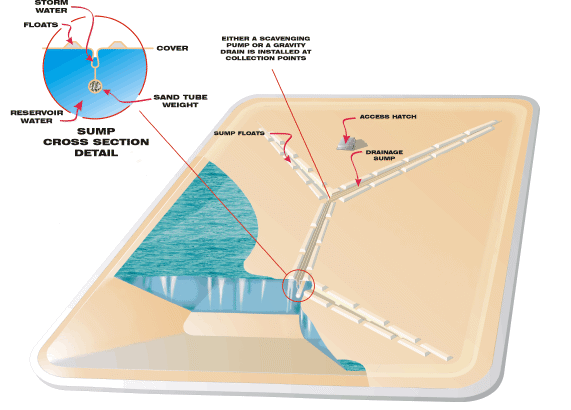
| |
Defined Sump dam cover system: Image from Layfield
|
|
Made by Layfield/C. W. Neal, this and
Revoc have a
page on the Net.
Layfield's blurb:
"Defined sump floating reservoir covers use a combination of attached closed
cell foam floats and sand tube ballasts.
These elements are used to create drainage sumps that collect and carry
storm water to either scavenging pumps or gravity drains for water removal
into a drainage system.
The floating cover itself is typically fabricated of reinforced Hypalon or
polypropylene geomembranes.
Floats and ballasts are encapsulated in geomembrane as well for maximum
longevity.
Our new lightweight evaporation control covers and algae control covers are
produced from unsupported Enviro Liner 6030.
Enviro Liner 6030 is a highly durable cover material which offers excellent
long term weathering capabilities and is NSF 61 certified for potable water
applications."
My thoughts
I suspect that installation would cause serious damage of the native
vegetation on
my dam wall.
The
Desert Knowledge CRC paper
gives an estimated cost (Dec. 2004) of $30/
2m, which is too
expensive for me.
I have no need to keep water and run-off out of
my dam – quite the contrary.
The
Net page is not very
informative.
It states several times that the product is a "Twin Plastic Board cover",
but does not state what the plastic is, nor any detail about construction.
It goes on to state; "Maintaining healthy water quality:
Our solution hampers bacterial growth by allowing natural UV light to filter
through and kill bacteria.
This helps maintain the water in a good condition."
This sounds highly questionable to me; bacteria are a very natural part of
any ecosystem, and while they are killed by ultra violet light, this would
only happen in the upper levels of any murky dam.
The Net page states that the cover is guaranteed for three years against
damage by UV light.
This seems to me to be inadequate; what about damage from wind and other
causes (such as animal feet)?
In any case a dam cover should have a life much greater than three years.
Cost
The Net page states that the cost is $8 per square metre, and installation
is done by the land-owner.
The product comes in 3mm or 5mm thickness "depending on the desired
application and strength"; presumably the $8 price applies to the 3mm
thickness.
Contact
New Fast Link Pty Ltd
Trading as Dam Covers Now
31 Cheam St, Dandenong North, VIC 3175
Ph: +61 3 9774 8303 | Fax: +61 3 9774 7336 | info@afb.com.au
E-Vap Cap is a floating polyethylene sheet cover; there is a
Net page.
The Net page states:
"The floating cover consists of a unique, multi-layered, polyethylene
membrane 540 microns in thickness that contains its own buoyancy cells.
It carries a 5-year pro-rata warranty against UV breakdown due to sunlight
exposure (independent NATA laboratory testing indicates a much longer
"life" expectancy than 10 years). Optional thicker material, up to 1000
microns is available giving greater warranty and a design life of 20 years."
An inquiry requesting price and installation requirements, 2009/08/18,
resulted in a quick response including a pdf file on E-vapcap and other
products by the same company.
This pdf file stated, among other things,
that "The covers feature a conditional ten year warranty,
however, testing indicates a much greater lifespan"; which is true, five
or ten year?
A request for a price resulted in a written quote from Bartlett Water
Services.
I had given 20m x 30m as the approximate dimensions of the surface of the
water in my dam when full.
Bartlett took my dimensions to be those of the dam at the top of the
batters, which would actually be considerably larger than my 20x30m.
They stated that the "quantity of material required including allowances
for top of banks, anchor trenches, welding overlaps etc is approx.
1011.842" and gave an approximate price of $10 175 plus
freight.
As the dimensions of my dam at the top of the batters would probably be
at least 25x35m it would seem the adjusted cost would be considerably higher,
perhaps $14 000, plus freight ($23 per square metre in my case).
Installation was not included in the quote.
None of the information I have read on E-Vap Cap says anything about whether
any significant contact between the air and the water in the dam is
maintained.
My general reading indicates that
such contact is
important.
My thoughts
This product is expensive, especially so as it must be large enough to not
only cover the water in the dam but also the anchoring trenches.
my dam
wall is well covered in native vegetation that has become established
over a period of 15 years; digging the anchor trenches and refilling them
would destroy much of this.
My reading on the evaporation barrier subject indicates that there must be
significant contact between air and water if there is to be no risk of
the water becoming anoxic, smelly, and deadly to most aquatic organisms.
Would this cover provide that contact?
What happens to dust, leaves, etc. that blow onto the cover, and rainwater
that falls on the cover?
How stable would the cover be in strong winds, especially when the water
level in the dam is low?
Quoting from
DKCRC, WaterSmart paper:
- Description:
- The cover is comprised of laminated 20 micron, stainless steel mesh
and 0.4mm bubble HDPE sheet.
The cover is anchored to the storage
floor by cables attached to a buried polyethylene pipe.
It is designed to only cover 90% of the water surface area.
- Manufacturer/Supplier:
- Reservoir Covers Australia (Pty Ltd proposed extension).
- Performance as stated by the manufacturer:
- May reduce evaporation by up to 90 per cent depending on the water
level of the storage.
- Costs:
- $3.50/m2 for complete installation.
- Durability:
- Life expectancy of 30 or more years – resistant to UV light and
oxidation.
- Installation:
- Not available.
- Advantages:
- It is simple and easy to install, heat reflective and self-protecting in
high winds (up to 150 kph) whether empty or full. The cover is also
suitable for all storage sizes, shapes and profiles up to 2 km wide.
|
Apparently Evap-Mat is a product of DeVere Mining Technology Limited,
who state on their
Evap-Mat Net page that it is "a low cost, long life floating cover for
water reservoirs and dams at mining sites".
DeVere also state that the project is temporarily on hold (2009/09/17).
My thoughts
The expected life is great, but why then is no warrantee period stated?
| |

| |
Fabtech dam cover: Image from
Fabtech
|
|
Fabtech have a page on the
Net.
They claim to have 25 years experience in liquid containment.
I did not find their Net page very informative.
I sent an email to admin@fabtech.com.au seeking more information regarding
a cover for my dam (2009/09/17).
Quoting from
DKCRC, WaterSmart paper:
- Description:
- An independent modular system made from UV resistant recycled
plastic – each module covers one square metre.
- Manufacturer/Supplier:
-
Indusium Pty Ltd and tested by the Queensland University of
Technology. Stoph Vanwensveen
- Email:
- stvn@bigpond.com (apparently no longer valid: DC)
- Performance as stated by the manufacturer:
- Reduce evaporation by up to 90%
- Costs:
- The anticipated cost is $4.50-8.00/m2
- Durability:
- Expected life of more than 25 years.
- Installation:
- This cover may be easily installed by the owner.
- Advantages:
- It has been shown to greatly reduce the effects of wave action, and is
easily installed by the customer.
|
I was unable to find anything on the Net connected with this product
(2009/09/17).
My thoughts
If it is easily installed by the owner then there must be no need for
earth-works to anchor it.
I like the fact that it uses recycled plastic.
No warrantee is mentioned.
Mentioned in the
DKCRC, WaterSmart paper,
apparently not commercially available yet.
Mentioned in the
DKCRC, WaterSmart paper,
apparently not commercially available yet.
| |
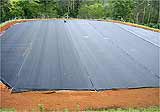
|
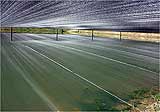
| |
Netpro dam cover: Images from Netpro's Net page
|
|
Netpro
produce a suspended dam cover.
Knitted shadecloth is supported by poles and high-tension steel cable.
The support structure lifespan is claimed to be 30 years, and the canopy is
expected to last more than 15 years.
My thoughts
The anchoring of the high tension steel cables would require major
disturbance of the native vegetation on
my dam wall.
Mentioned in the
DKCRC, WaterSmart paper,
apparently not commercially available yet.
My thoughts
Polynet is based on polystyrene sheets wrapped in a net.
Polystyrene becomes chalky and powdery when exposed to sunlight for long
periods.
Quoting from
DKCRC, WaterSmart paper:
- Description:
- Quit Evap is a rectangular modular floating cover, manufactured from
0.5-0.75 mm thick polypropylene sheet with polystyrene floats.
The modules are interconnected by Velcro straps. The full scale modules
are up to 5 m x 25-30 m.
- Manufacturer/Supplier:
- SMEC Australia Pty Ltd. (Contact: Peter Chapman)
Address: 1st floor, 105 Denham Street Townsville Qld 4810
Phone: (07) 4771 6119
Fax: (07) 4771 6120
Email: Peter.Chapman@smec.com.au
- Performance as stated by the manufacturer:
- Can effectively achieve 90-95 per cent coverage of the water surface
and reduce evaporation by 85-90 per cent.
- Costs:
- The estimated cost is around $6.00-8.00/m2 plus transport and
installation.
- Durability:
- The cover has a minimum life span of 5 years with a potential life of
8-10 years – the cover is also UV stabilised.
- Installation:
- Installation of this product is easy and may be done by the owner.
- Advantages:
- Lightweight and easy to install.
|
My thoughts
A life span of five, even eight, years is not long enough.
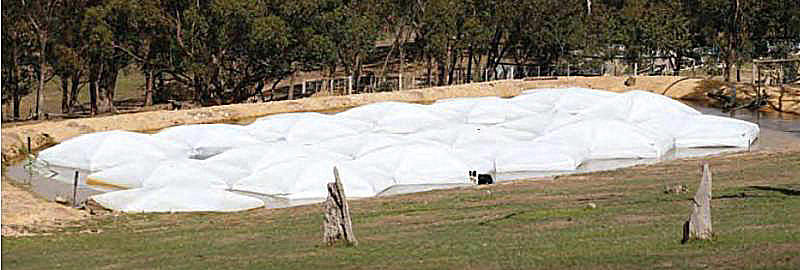
|
A Raftex cover on a dam
Image from Raftex
|
Raftex is a product of F Cubed Australia Pty. Ltd., 23 Millennium Park
Drive, Whittlesea, Victoria, Australia, 3757.
They can be reached at email fcubed@fcubed.com.au
It is claimed that "Raftex has been comprehensively tested by the
University of Southern Queensland for the National Centre for Engineering
in Agriculture.
The Raftex units are hexagonal and link together – with sufficient
space between units to allow proper aeration of the water and for rainwater
to get into the pondage.
Each panel weighs 16kg, covers 16m2 of water and is made of
galvabond steel tubing, polystyrene foam, and polyethylene film.
It has a 10 year guarentee.
Apparently a minimum of 30cm of water should be left in the dam at all
times to anchor the panels.
My thoughts
The requirement for a minimum of 30cm of water in the dam is a concern;
how could one make sure that there is always at least that much water left
in the dam – after all, lack of water is the problem that these
devices are supposed to solve.
And in a small dam that may only be two or three metres deep, 30cm
represents a considerable volume of water.
What life would the galvanised steel have in a continually damp situation,
especially if significant salinity was involved?
A guarentee is not much use if the company behind the product goes broke.
| |
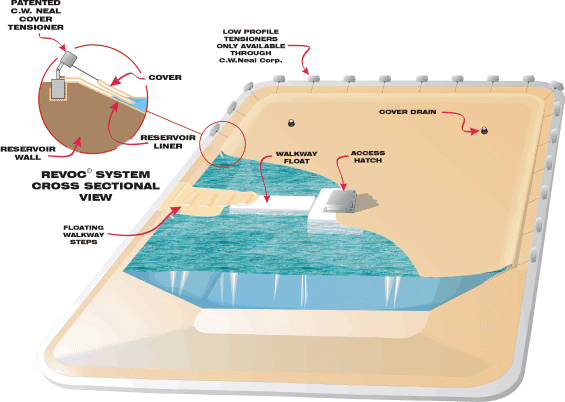
| |
Revoc dam cover system: Image from Layfield
|
|
Made by Layfield/C. W. Neal, this and
Defined Sump have a
page on the Net.
Layfield's blurb:
"REVOC Floating covers use patented tensioners attached around the perimeter
of the cover system to prevent undue cover movement and wrinkling
regardless of the reservoir's water level fluctuation.
Tensioners also serve to retain slack cover material in a defined peripheral
sump.
Cover drains conduct storm water into a drainage system.
The floating cover is typically fabricated of reinforced Hypalon or
polypropylene geomembranes.
Floats and weights are encapsulated in geomembrane for maximum longevity.
REVOC floating covers offer lower maintenance and lower replacement cost
than other floating cover type."
My thoughts
Installation of the tensioners would cause serious damage of the native
vegetation on
my dam wall.
The
Desert Knowledge CRC paper
gives an estimated cost (Dec. 2004) of $30/
2m to Layfield's
other dam cover,
Defined Sump, which is too
expensive for me.
I have no need to keep water and run-off out of my dam – quite the
contrary.
This is a powder that is spread over the surface of the water.
It is claimed that evaporation is reduced by "up to 50%".
I believe that it needs to be replaced at fairly frequent intervals.
Flexible Solutions have a
Net page on WaterSavr.
On 2013/09/03
Dr Chris Fellows, Senior Lecturer in Chemistry, School of Science and
Technology, University of New England, Armidale NSW was kind enough to
provide the following in regard to WaterSavr:
"It is a substance called hexadecanol mixed with lime to help it spread on
the surface.
The hexadecanol is innocuous and will degrade quickly (bacteria eat it)
– probably even faster than you saw the
Aquatain degrade, I expect [you]
would have to apply it every three or four days.
There wouldn't be enough lime in the small amounts used to make much of a
difference to the pH of your dam, so there should be no worries at all about
soil or water quality.
(Products like it have been used in very large scale trials since about
1950 – which is an indication that no one has figured out how to get
reproducible results from it yet, or we would be applying it routinely
everywhere!)
What will do the job with WatrSavr is an invisible layer only one molecule
thick that spreads out from the powder particles, so you don't need to cover
your whole dam with powder – any remaining powder on the surface is
just an indication that it hasn't all degraded yet.
Our work here suggests that besides the degradation problems, it won't have
any appreciable effect in still air or high winds, but could be effective at
reducing evaporation at wind speeds between about 5 and 15 kph."
My thoughts
In effect it sounds similar to Aquatain, which I have tried and been
disappointed with.
| |
| Floating PV panels proposed for Jamestown, South Australia
|
|---|
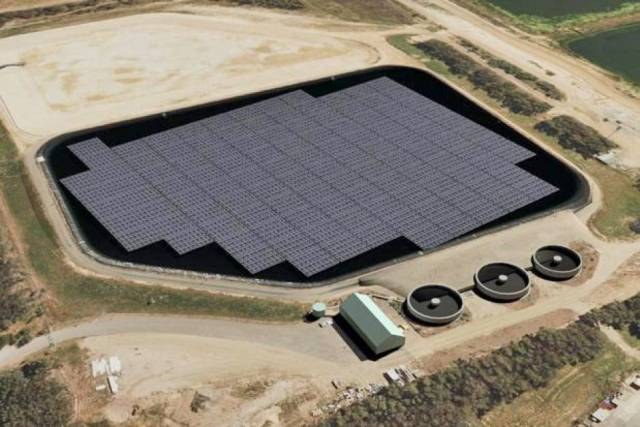
| | Image credit ABC
| |
Geits ANZ has proposed a floating solar power plant on common effluent ponds
at Jamestown in Mid North South Australia.
See an article on
ABC by Matthew Doran.
| |
Evaporation losses in pumped hydro dams
Floating solar panels could
be used to both generate power and reduce evaporation from pumped hydro
water storages.
|
|
The proponents say that the water will cool the panels and that this will
"prove at least 50 per cent more efficient than a land-based solar power".
While cooling the panels certainly does increase their efficiency in
converting light into power this claim is an exaggeration.
Whether the water is actually in contact with the solar panels is not stated.
Have they considered the fact that by virtually stopping
evaporation and by transferring the heat from the panels into the water they
will be heating the water?
The exposed (warm) water around the sides of the pond will evaporate
relatively quickly and cool the whole of the water body to some extent,
but of course this will lessen the desired evaporation reduction aim.
While the panels will heat the water during the day, quite a bit of that heat
will then radiate away during the night
(Passive cooling by radiation).
However it is not possible to have both maximum cooling effect on the panels
and maximum reduction in evaporation at the same time.
It is a very innovative and commendable project and should work very
well, although perhaps not quite so well as the proponents are claiming.
There are more products out there for reducing evaporation.
I'd be grateful if any reader can tell me anything useful about other system,
or those mentioned above,
especially if they have had personal experience with them; my
email address is at the
top of this page.
Also see Using waste materials.
Evaporation from a water surface is greatly increased if there is a wind that continually removes the thin layer of saturated air in contact with the water surface and replaces it with dry air.
Reducing the wind speed across the surface of the water reduces evaporation and various wind-breaks, including floating fences, can help.
Reducing the wind speed would also be valuable if a monolayer of chemical (such as
Aquatain, mentioned elsewhere on this page) is used.
I was informed about floating fences, I haven't researched them myself.
A paper,
The effect of wind on evaporation suppressing films and methods of modification by Franklin R. Crow, discusses the use of monolayer evaporation barriers and wind-breaking fences.
I have wondered if a floating plant mat, perhaps consisting of something like the fern
Azolla filiculoides might be effective, but
research carried out by Saintly and Associates (New South Wales) for the Cotton Research and Development Corporation and published in July 1995 found that "
Azolla filiculoides does not reduce evaporation significantly enough to warrant further testing."
The same report discussed the use of other plants too, with similarly disappointing results.
Another
report, published in "Environmental Solutions" 2007/08/05, author not stated, was brought to my attention by an interested reader.
It is worth quoting several paragraphs:
"The more floating-leaved plants present, the less evaporation, because there is less exposed water for evaporation. At the same time, emersed and floating plants, such as cattail and water hyacinth, because of their structure and leaf area, transpire more water than would evaporate in the same area. Therefore, lakes filled with emersed and floating plants will lose more water to the atmosphere than will open water lakes having few plants. Lakes covered with water hyacinth will lose water much more quickly than will open water lakes.
On the other hand, floating-leaved plants, such as duckweeds and lotus, that have flat, often overlapping leaves, reduces evaporation, because there is less exposed water for evaporation, but also, because their structure and habit is different from emersed and floating plants, do not transpire as much water as would evaporate in the same area. Therefore, lakes with many floating-leaved plants will lose less water than will open water lakes. Lakes covered with duckweed will hold water for a longer time than will open water lakes.
Evapotranspiration Losses Over Evaporation Losses
(Numbers less than 1.0 mean that those plants actually reduce water loss.)
Eichhornia crassipes (water hyacinth) transpires 1.26, 1.62, and 2.7 times the amount of water as would evaporate over open water
Typha latifolia (cattail) 1.75, 1.8, 2.5, 2.0
Acorus calamus 2.0
Scirpus validus (bulrush) 1.9
Panicum rigidulum (panic grass) 1.58
Juncus effusus (rush) 1.52
Carex lurida 1.33
Alternanthera philoxeroides (alligatorweed) 1.26
Pontederia cordata (pickerelweed) 1.2
Justicia americana 1.17
Nymphaea odorata (water lily) 1.0
Lemna minor (small duckweed) 0.9
Wolffia columbiana (water meal) 0.89
Spirodela polyrhiza (giant duckweed) 0.85"
Note, even the best plants only reduced evaporation by 15%.
I considered making a shade cloth cover for my dam.
It would shade the water and greatly reduce wind velocity over the water;
both factors reducing the evaporation rate.
I decided against the idea, having used shade cloth in areas exposed to
wind I knew that is could suffer from wear if it was to move at all over any
supporting structure, and I decided that the support it would need would
be complex and expensive.
The cost of the shade cloth itself would also be quite high.
Selected flotsom picked up from beaches could be useable.
Scrap plastic bottles are available in big numbers, but I suspect they
would have a short life if exposed to sunlight; if the bottles themselves
didn't deteriorate, the caps might.
Also they could blow off the dam's surface, unless they were partly filled
with water.
South Australia's container deposit would pose an administrative problem
here.
Wine bottles are available in large numbers at no cost from at least some
recycling agents.
Unfortunately a very large number of wine bottles (about 60/m
2,
around 42 000 for my dam) and some very cheap way of sealing them
would be needed.
The time required for collecting and sealing the bottles would make the
project impractical.
Glass objects can be produced cheaply and glass has a very long life in
the open and would not cause any pollution of the water in the dam.
Could purpose-made glass floats be made at a competative price?
Installing the glass floats without smashing them would pose a technical
problem.
Old tractor tires are freely available in agricultural areas where there
are also many dams.
Used 20L pesticide containers are also plentiful.
Cleaned 20L containers can be used to make floats (four to a tire) inside
the tractor tires; the tires would protect the containers from most sunlight.
Why not float scrap wood on the dam's surface?
Untreated wood will, I believe, become waterlogged, sink, and rot; not only
becoming useless, but polluting the water.
I wouldn't use wood treated with copper, chrome arsenate (CCA, the green
stuff) because of the risk of the heavy metals leaching into and poisoning
the water.
What about wood treated with creosote?
The creosote would stop the wood from rotting and might stop it from
becoming waterlogged.
It would be unadvisable to use water from any dam with creo scrap floating
on it for drinking or for water for animals to drink, but it might be
harmless for irrigation of plants?
I'm thinking something like creo posts pulled out of old vineyards;
the creosote would be much more bound to the wood in such old posts than
in new ones.
It would be possible for scrap wood to be coated with something to
waterproof it, but this doesn't seem to be something the dam owner could
practically do.
Could wood be protected from waterlogging by encasing it in recycled plastic?
It might be a business opportunity.
Saintly and Associates (New South Wales) did
research on reducing evaporation rates from water storages for the Cotton Research and Development Corporation and published in July 1995.
Environmental Solutions; "Do Lotus Leaves Reduce Evaporation in the Lakes in Drought Times?"; the piece discusses a number of plant species that were tested.
Other links are within the sections on various products.
| |
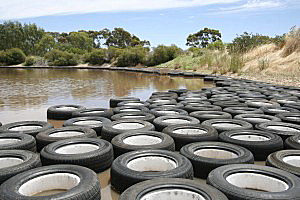
| |
AgFloats (Mark 2) on my dam. The first of several deliveries.
|
|
I ordered 700m
2 of
AgFloats for my dam.
The first truck load of 740 tires were delivered just before Christmas of
2009, the second in February, and the third on 2010/03/16.
(ReClaim were having more trouble than they expected in getting the
production system running properly, I believe they were going to do a major
rebuild in the cool half of the year after the demand had dropped.)
I had some concern for the stability of the polystyrene because of it
being exposed to sun and weather.
By May 2010 there was some evidence of birds having broken some of it away from some tires, but nine years later the polystyrene was still very much in place.
I've written about my experiences with the AgFloats
below.
| |
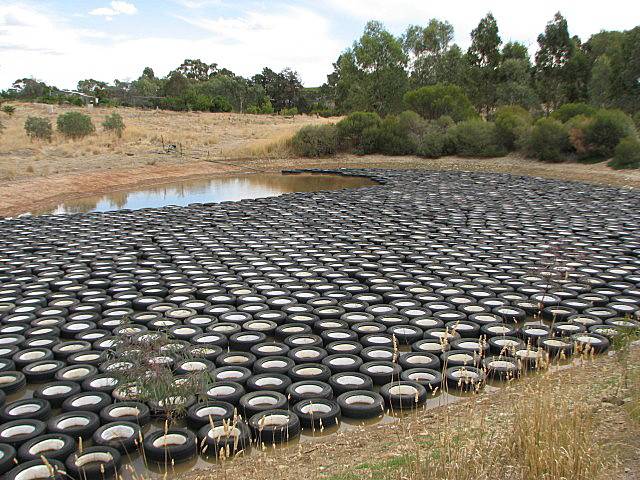
| |
About 2100 AgFloat tires on my dam the day of the third delivery,
16 March 2010.
|
|
About 80% of the water was covered at the time the photo on the right was taken, but once the dam refilled there would be much more open water.
I intended possibly buying more AgFloats later.
A total of 247 kL of water had been pumped in the season, I estimate three times that had evaporated.
To be clear I will confirm that there is nothing in the circle where the wheel went when the tires were on cars.
Unfortunately the company that made AgFloats went out of business a year or so after I installed them.
To what do I attribute the effectiveness of the AgFloats?
Of course the AgFloats do not reduce evaporation from the parts of the dam that they do not cover.
I believe that they are very effective in reducing evaporation from the parts of the dam that they do cover, even though they provide a direct evaporation barrier to only about 50% of the water surface, because they reduce the velocity of the wind on the water surface.
On a calm day a thin layer of air in contact with the water surface becomes saturated with water vapour.
Evaporation from a water surface is greatly increased if there is a wind that continually removes the thin layer of saturated air in contact with the water surface and replaces it with dry air.
Reducing the wind speed across the surface of the water reduces evaporation by reducing the rate at which the layer of saturated air is replaced with dry air.
Unexpected
By 2016 a number of redgum trees had become established in some of the tires.
I have written about this on
another page on this site.
| |
| Aerial view of the dam, taken by my drone, 2016/01/02
|
|---|
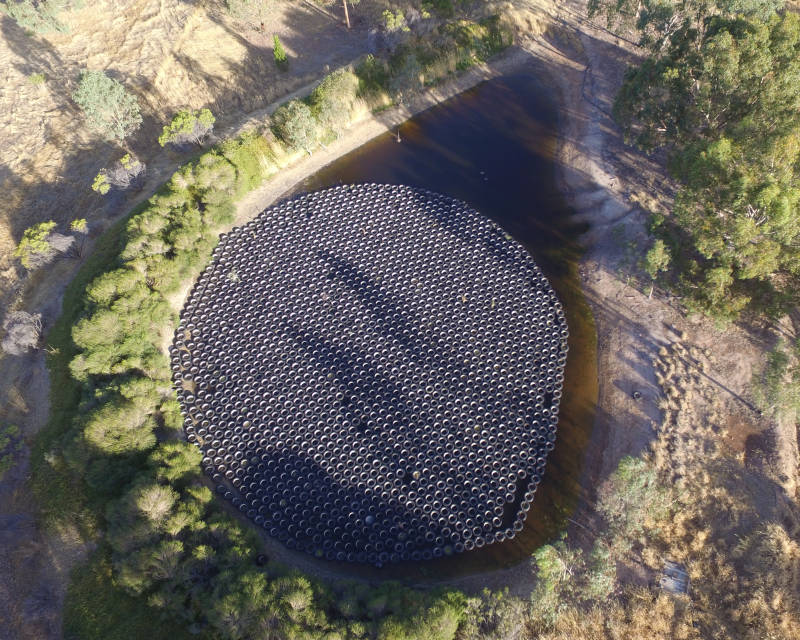
| | The tires were, at this time, to some extent held in a group by a rope threaded through the tires on the outside of the circle.
| |
The AgFloats are very effective at reducing evaporation.
Before the tires I estimated that my dam had gone completely dry about one year in three.
Since the tires were put in about the end of 2009 it has not dried out once.
If they were still commercially available I would recommend them.
In the Clare Valley, where my dam is, there was very little run-off in 2018.
I have no doubt that my dam would have gone completely dry before the end of that year without the AgFloats.
With the AgFloats I still had a little water in mid March 2019 (the water level had dropped so low that I couldn't pump at the end of March).
Water is most needed locally between October and April, so the dam got me most of the way through the dry season when it was needed.
The photo on the right shows that there are far fewer tires than would be required to cover the entire dam when it is full.
Challenges/limitations
The fact that only about half of the total area of the dam, when full, is covered with AgFloats has led to several challenges and limitations.
I didn't buy enough to cover the whole dam because of the cost.
- When the water level is high evaporation rates are much higher than they would be if the whole of the dam was covered;
- As the water level falls I need to put the tires that become stranded on the banks back into the water;
- A few weeds have started growing in the tires (including the gum trees mentioned elsewhere).
These have not become a serious problem.
(Just before writing this section I did have to drag a small floating island, consisting of two tyres and a mass of reeds and roots, out of the dam.
Reeds, Typha or Phragmites, if they became established, would greatly increase evaporation.)
- I've tried a rope 'woven' through the tires on the outside of the mass to hold them together (see photo on the right).
I found that some tires escaped over the confining rope and had to be put back.
I still had the problem of tires stranding on the banks of the dam.
In the end I took away the confining rope.
General observations
- The tires are too heavy to be moved out of the dam by strong winds, nor do they ride up on top of each other;
- In the ten years that the floats have been in place degradation of the polystyrene foam has been slight, the degradation of the rubber has been negligible;
- There has been little, if any, reduction in the buoyancy of the polystyrene foam, the tyres float just as far above water level as they did when new;
- There seems to be no harmful contamination of the dam water, there are still yabbies, frogs calling seasonally (loss of frogs have been found elsewhere to be a sensitive indication of pollution), and vegetative growth in the dam;
- There is no 'rubbery' taste to the dam water (my wife and I don't drink it, we only use it for gardening).
